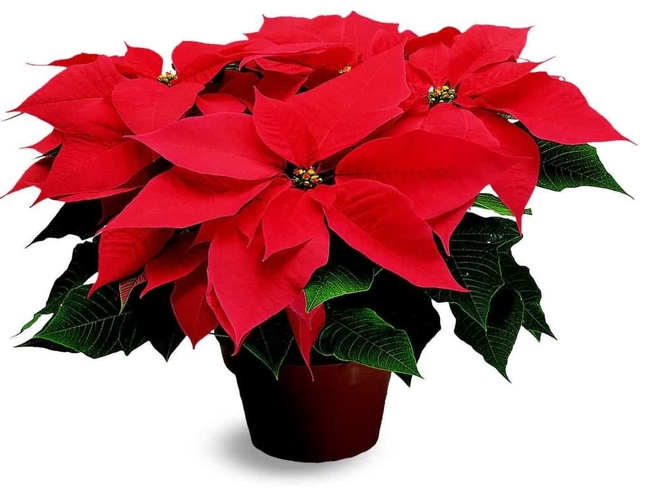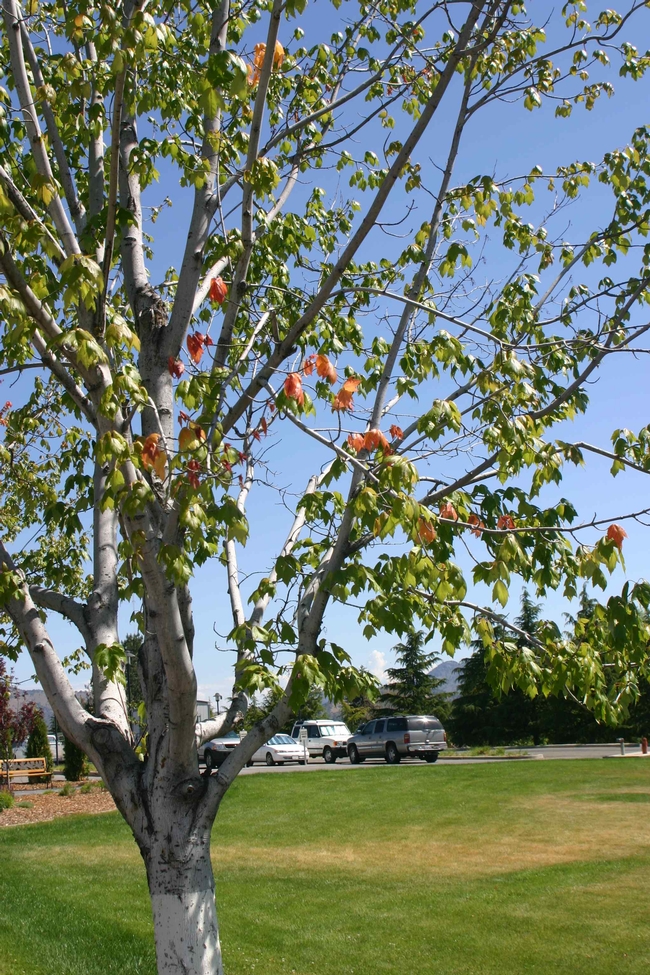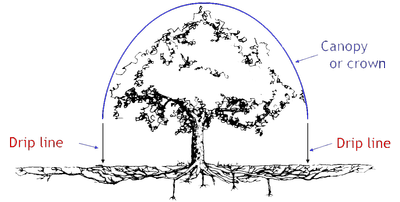From the UC Blogosphere...
Re-blooming a Poinsettia? Next Year?
Help for the Home Gardener from the Contra Costa Master Gardeners Help Desk
Client's Situation and Questions (in early September)
My questions:
When? How long? Do I water while it is in a dark spot?
When I do bring it out should I give it fertilizer? If so, what kind?
CCMG's Help Desk Response (in mid-September)
Thank you for contacting the Contra Costa Master Gardeners. Getting Poinsettia to re-bloom is a fairly simple procedure, though it requires care and follow through.
Poinsettia are a short day flowering plant, which means they begin the blooming cycle with the onset of shorter day length in the growing season. You will need to prevent your plant from receiving any light for 12 to 14 hours during the night. Starting at the end of September/ beginning of October you will need to cover it or place it in a dark space, such as a closet away from all artificial light starting around 5pm and then uncover it during the day around 8am and place it in a bright window. You will need to do this until the red bracts begin to form in about a month or two (usually in November). Just keep checking as you bring it out from cover each day. You will also want to keep the temperature below 70 degrees F and above 50 degrees F at night (55 to 60 degrees F being optimal). Don't leave it in the dark place all day and night for 2 months, it will die.
For watering you will want to water as you do during the normal growing season, just make sure it dries out between watering and that it does not sit in water or remain soggy. Poinsettias, being in the Euphorbia family, are somewhat drought tolerant and don't like to be over watered.
For fertilizer you can just use an all-purpose houseplant fertilizer at the recommended rates in the instructions. You will only need to fertilize when the plant is actively growing, not when it is flowering. That would mean no fertilizer when you bring it out of the closet and it begins blooming. Fertilizing during its active growth phase after it has finished flowering every 2 weeks to every month should be adequate, depending on how strong the fertilizer solution is.
For more information on Poinsettia care and re-blooming please refer to the following websites: http://urbanext.illinois.edu/poinsettia/index.cfm
http://faculty.ucc.edu/biology-ombrello/pow/poinsettia.htm
http://aggie-horticulture.tamu.edu/archives/parsons/flowers/poinsettia.html
Best of luck with re-blooming your Poinsettia.
Thanks again for your interest in Master Gardeners.
Contra Costa Master Gardeners Help Desk
Editor's Note: The Contra Costa Master Gardener Help Desk is available year-round to answer your gardening questions. Except for a few holidays, we're open every week, Monday through Thursday from 9:00 am to Noon at 75 Santa Barbara Road, 2d Floor, Pleasant Hill, CA 94523.
We can also be reached via telephone: (925) 646-6586, email: ccmg@ucanr.edu, and we are on the web at http://ccmg.ucanr.edu/
Roses
Roses By Tami Reece UCCE Master Gardener I would like to plant a rose this spring....
Monitoring the Monarchs
Like the migratory animals that he studies, Hugh Dingle, emeritus professor of entomology at the University of California,...
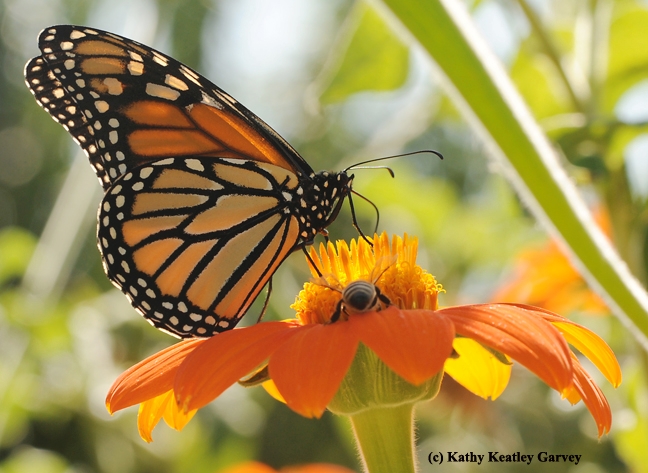
A monarch and a honey bee sharing a Mexican sunflower, Tithonia. (Photo by Kathy Keatley Garvey)
It's Crunch Time: Almond Conference Dec. 9-11
It's crunch time. Officials organizing the 42nd annual Almond Conference are gearing up for their three-day event, which...
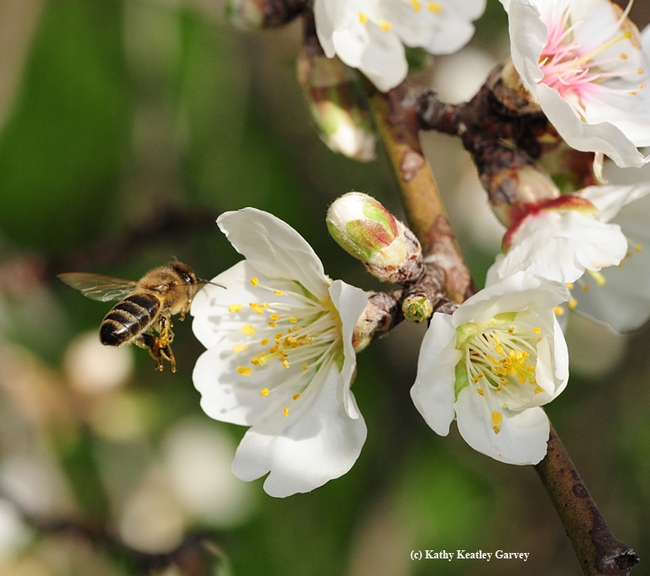
Honey bee pollinating an almond blossom. (Photo by Kathy Keatley Garvey)
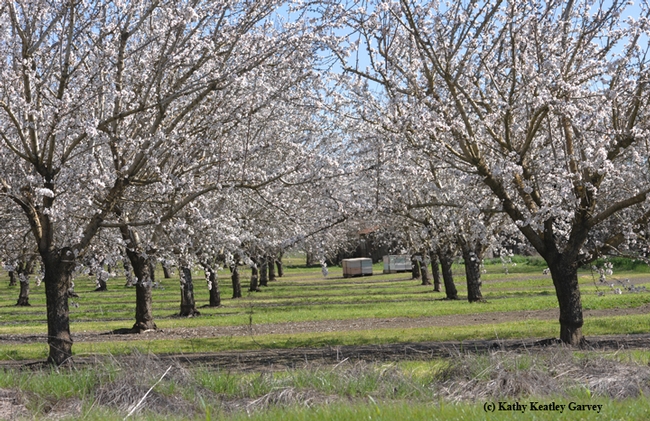
An almond orchard in spring of 2013 in Dixon. (Photo by Kathy Keatley Garvey)
Save Trees during Drought with New Tree Ring Irrigation Contraption (TRIC)
From a majestic oak, giant sequoias or a swaying palm there is nothing quite as beautiful in this world than a tree. They can provide us with shade, fruit, flowers and most importantly are the “lungs of planet”. While we have enjoyed some wet weather over the last week, California is still suffering from extreme drought conditions.
Prioritizing Trees for Landscape Water Use
Many residents have been encouraged to reduce water use by turning off their outdoor watering systems, but this may be causing stress to established trees that are becoming increasingly thirsty for water.
In most traditional residential landscapes trees are surrounded by turfgrass. Turfgrass surrounded trees take advantage of the frequent and shallow watering schedule, typically set to help the lawn flourish. When residents eliminate or reduce water for lawns, trees cannot easily adapt to the new water shortage.
“Mature fruit trees and landscape trees are worth saving! Recognizing early signs of drought stress is important because irreversible damage can occur that no amount of watering will correct.” said Janet Hartin, UC Cooperative Extension advisor in a recent article, Save Water, But Also Save Trees During a Drought.
Replacing small plants, lawns and shrubs is easy compared to a large tree which takes years to become established. Saving mature trees during a drought should be a top priority in your landscape water use allocation.
“Two seasons without enough water can result in severe drought stress and even kill a tree,” warned Hartin. “Also, drought-stressed trees are more prone to damage from diseases and insects than non-stressed trees.”
Understanding how to water a tree effectively is important to avoid water waste and to ensure that the tree is receiving the correct amount of water for its survival.
One key factor to successfully watering a tree is understanding what soil type is present. Understanding soil types is an important factor in determining how much water is stored in the ground. For example, sandy soils dry out quickly while clay soils retain more water. Contact your local UC Master Gardener Program to learn how to determine your soil type.
Tree Ring Irrigation Contraption (TRIC)
Recently the Calif. Center for Urban Horticulture (CCUH) at UC Davis, UC Division of Agriculture and Natural Resources (ANR) and Ewing Irrigation devised a unique watering system called the Tree Ring Irrigation Contraption (TRIC). Using previous data from Netafim drip tube tables and from the Irrigation Association Landscape Irrigation Auditor manual, the partners envisioned a possible solution to mitigating drought conditions and the effect on landscape trees. The TRIC is an inexpensive kit that homeowners can put together for around $100 for one large tree.
The TRIC could enable homeowners to adequately water trees to a depth of three feet with confidence, by using the recommended parts and using the TRIC calculator with accurate information. Aside from a recommended parts list, there is a “plug-in” calculator created by Dr. Loren Oki, UC ANR Associate Specialist in Cooperative Extension Landscape Horticulture for UC Davis & UC ANR. The TRIC calculator helps determine the run-time needed for the device.
Learn more by visiting:
- CCUH – Tree Ring Irrigation Contraption website
- TRIC Parts List
- TRIC Calculator
- TRIC PowerPoint Presentation



